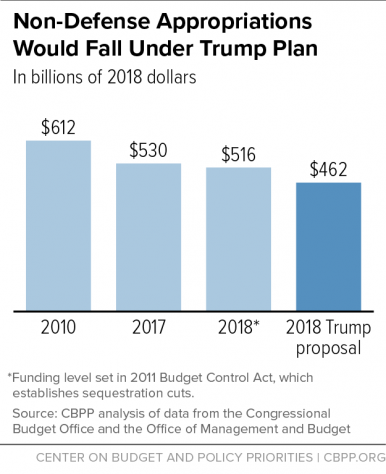Trump’s budget priorities mean cutting almost everything the government does
On Tuesday night, President Trump will speak before Congress about his legislative priorities. One he’s bound to mention is his upcoming budget outline, which will lay out where he wants to cut and increase government spending. He’s already described some of the things he wants to do in his budget: increase defense spending by $54 billion, while leaving Social Security and Medicare as is.
If he were to actually follow through on everything he says he wants to do, it would basically mean that the Department of Defense and entitlement programs would be the only things left in the government.
On Monday, Trump’s team said it would call for an equal decrease in the pot of government funding known as non-defense discretionary spending to make up for the increase in military spending.

Non-defense discretionary spending is a catch-all phrase for a huge number of government functions. The money funds educational programs like Head Start, Pell Grants, and K-12 services; core government duties like law enforcement and collecting taxes through the IRS; health and scientific research; nutrition, rent, child care, and home heating assistance for low-income people; public safety through the CDC and FDA; infrastructure like the National Highway System and air traffic control; environmental programs through the EPA; and the protection and preservation of national parks.
According to an analysis by the Center on Budget and Policy Priorities, a $54 billion cut would drop spending for these programs — minus the Veterans Administration, for which Congress already passed increased funding — 15 percent below their current level.
But the cuts would actually end up being deeper if they come on top of spending caps Congress mandated in 2011 that are set to take effect in 2018 after two years of putting them off. To even get his increase in defense spending, Trump would have to convince Congress to undo the cap mandated by law under sequestration.
Sequestration means that non-defense discretionary spending in 2018 is scheduled to be 16 percent lower than what it was in 2010, adjusted for inflation. If it’s cut by another $54 billion, that would drop spending a full quarter below what it used to be.
That would bring spending on these programs to the lowest level ever recorded. The current low point was 3.09 percent of GDP in 1962; Trump’s cuts would bring it below 3 percent.
In an interview with Fox on Tuesday morning, Trump argued that his increase in defense spending could be covered not by severe spending cuts elsewhere, but by an increase in economic growth. “I think the money is going to come from a revved up economy,” he said, promising to grow GDP to 3 percent or more a year.
It’s unlikely he can achieve significantly higher growth, however. The Congressional Budget Office predicts that the economy will grow at 2.1 percent this year, and while there may be some slack in the economy that leaves room for more with all the right policies, there probably isn’t a whole lot.
A president doesn’t have to balance the budget, and Trump could just call for an increase in defense spending, a huge tax cut, a ramp up in infrastructure spending, mass deportations, and money to build a border wall without paying for it. But he repeatedly promised on the campaign trail that he would balance the budget.
Doing so, while also sticking to his pledge to leave Social Security and Medicare alone — two of the biggest drivers in government spending — would basically require cutting everything else that the government does. According to a calculation by Senate Budget Committee staffer Robert Kogan, it would mean a 93 percent cut from where things stand now within 10 years.

